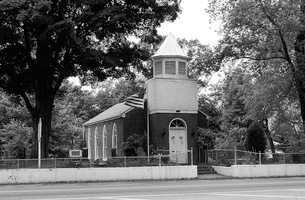 | Back to e-WV
| Back to e-WV
 The West Virginia Encyclopedia
The West Virginia Encyclopedia
 | Back to e-WV
| Back to e-WV
 The West Virginia Encyclopedia
The West Virginia Encyclopedia

Virginia’s Chapel is located at Cedar Grove. Also known as the Little Brick Church, it was built in 1853 by William Tompkins Jr., a successful entrepreneur in the early salt and natural gas industries in the Upper Kanawha Valley. The chapel is named for Rachel and William Tompkins’s daughter, Virginia.
Constructed of red bricks made on site, the original building was nearly square, with three narrow Gothic windows on each side. A few years later, new construction lengthened the chapel, adding a fourth window on each side and an octagonal cupola atop the entrance.
In its early years, the chapel was nondenominational. During the Civil War, both sides used the building at different times. Union soldiers housed their horses in it, and the Confederates converted it into a hospital. The Glasgow and Cedar Grove Methodist churches shared the chapel until the 1920s.
Over the years, the Tompkins family and community members contributed money for the chapel’s upkeep. In 1975, the chapel was placed on the National Register of Historic Places. No longer an active church, Virginia’s Chapel is used for weddings, funerals, a Thanksgiving service, and Easter sunrise service. Two cemeteries are located on the chapel grounds. Local white residents are buried in one, and African-American slaves are buried in the other.
Read the National Register of Historic Places nomination.
Written by Nancy Ray Adams
Perry, Bud & Karl C. Lilly III. Reopening Glen Rogers. Sissonville: PAL Productions.
Reid, H. The Virginian Railway. Milwaukee: Kalmbach Pub. Co., 1961.
Virginian Railway Feature. Sam R. Pennington's Feature Stories Magazine, (June 1933).